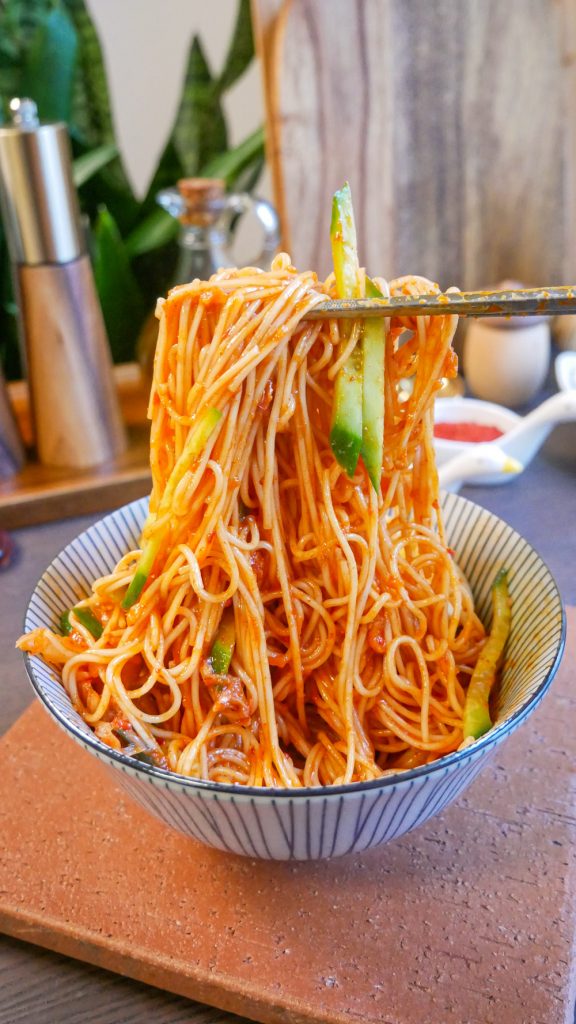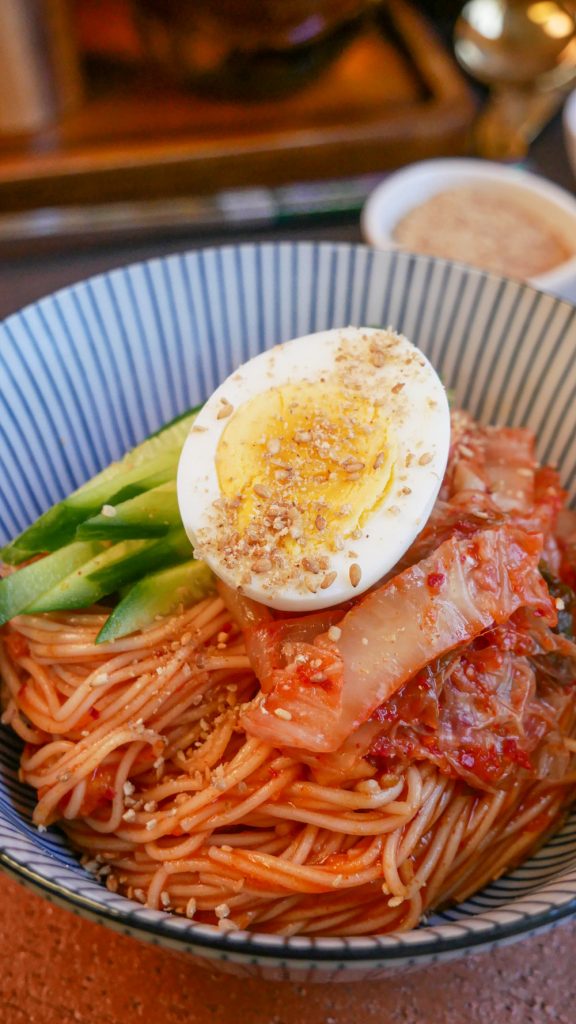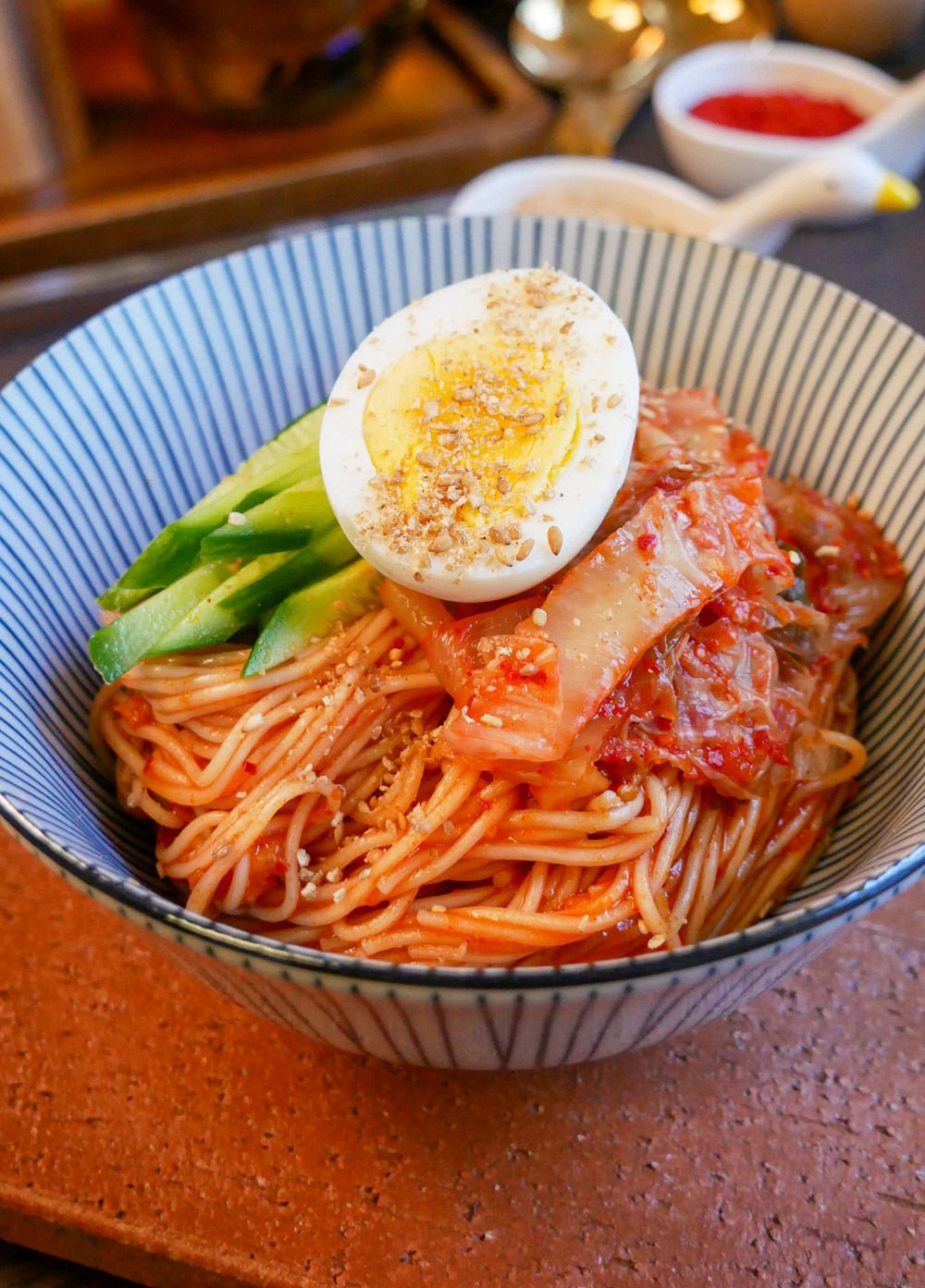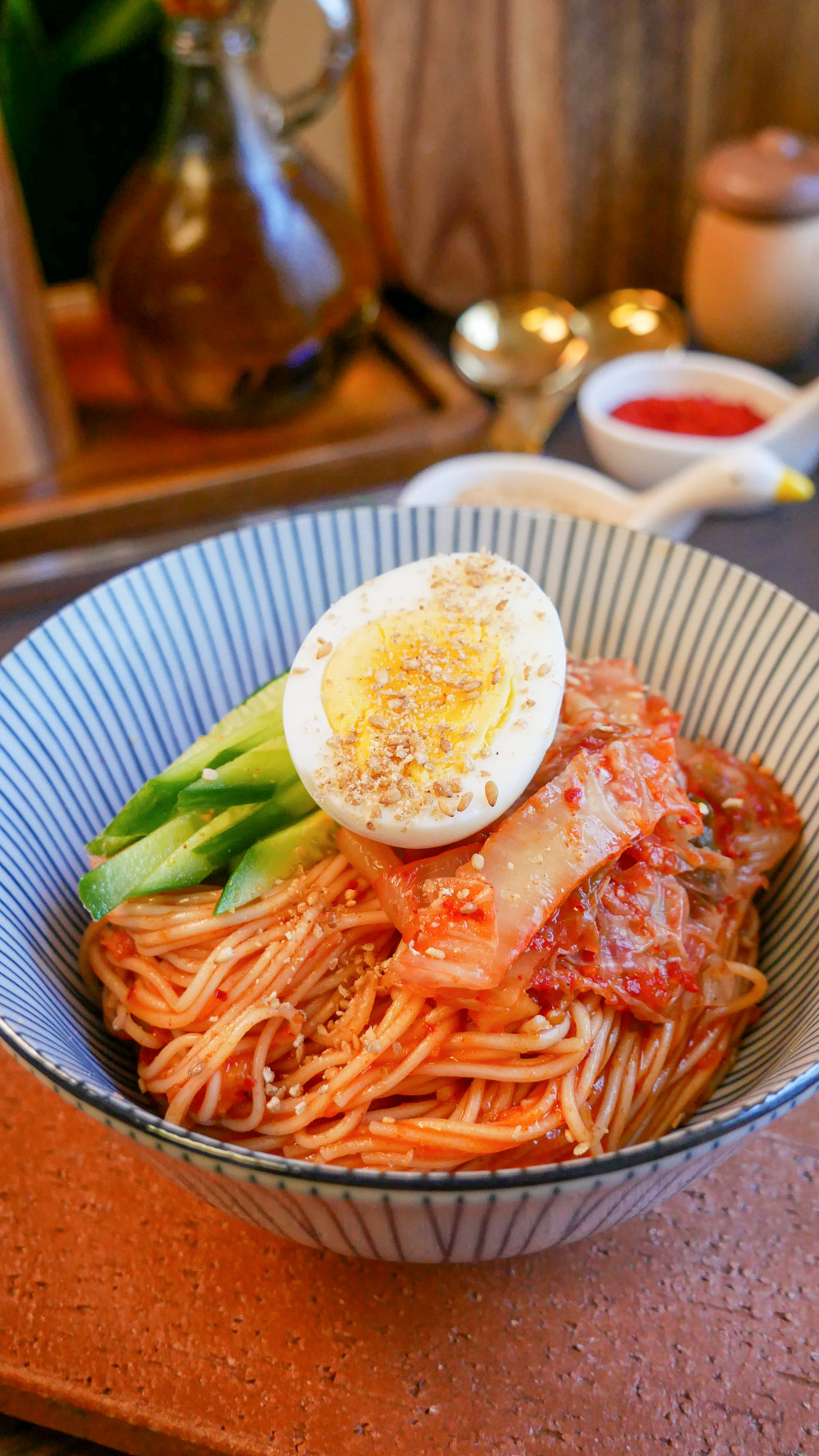Korean spicy cold noodles or ‘bibim myeon‘ (비빔면) (also known as ‘bibim guksu‘ – 비빔국수) are a summer favorite in Korea. It’s a spicy, sweet, and tangy cold noodle dish that’s perfect for when you’re craving a refreshing and nourishing meal. Not only is it absolutely delicious, it’s incredibly easy to make! It’s ideal for days when you don’t want to spend too much time in the kitchen or cooking over the stovetop. 10 minutes is all you need to make this refreshing meal.
If you’re looking for more easy summer cold noodle dishes, check out my Cold Soba Noodles recipe!

Why you’ll love this recipe
If you’re a spicy noodle lover, you’ll absolutely love this recipe! This bibim myeon dish is the ultimate summer meal and a great refresher for those unbearable hot and humid days. A slurp of these cold noodles will instantly cool you down and make you crave more.
One of the best things about this recipe, aside from the ease of preparation is its versatility. While I topped my spicy cold noodles with kimchi, cucumbers, a hard-boiled egg, and sesame seeds, you can experiment with different toppings and tailor them to your palate. Other delicious toppings include sliced onions, garlic chips, assorted leafy greens, avocado, and more!
Did I mention how easy this recipe is to prepare? All you need is 10 minutes to prepare this delectable noodle dish. It’s a lifesaver for days when spending time in the kitchen is just not feasible.

How do I prepare Bibim Myeon?
This Korean spicy cold noodle dish is incredibly easy and straightforward to prepare. To get started, just follow the steps below!
Step 1: Prepare the sauce
In a small bowl, combine gochujang, gochugaru, sugar, grated garlic, apple, soy sauce, sesame oil, kimchi juice, and 1 tbsp sesame seeds. Mix until well combined then set aside.
Step 2: Cook the noodles
- Cook the somyeon noodles according to the package instructions, about 3 minutes. Strain then thoroughly rinse under cold water.
Step 3: Assemble the dish
Transfer the rinsed somyeon noodles into a mixing bowl. Pour the sauce on top then mix until the noodles are well coated.
Step 4: Garnish and serve!
To serve, transfer the noodles into a bowl. Garnish with kimchi, cucumbers, a hard-boiled egg, and sesame seeds.
Bibim Myeon Ingredients & Substitutions
Somyeon noodles: these are Korean thin wheat flour noodles that can be found at your local Korean supermarket or on Amazon. You can substitute it with any thin wheat noodles including makguksu.
Gochujang: the gochujang is the foundation of the sauce. Keep in mind that gochujang is sold in varying levels of heat – mild, hot, and very hot. I find that the mild version is perfect for a recipe that requires a significant amount gochujang, like this one because it allows you to control the spiciness.
Gochugaru: the gochugaru will level up the spiciness in this dish. Feel free to adjust the amount of gochugaru added based on your spice level tolerance.
Sugar: the sugar will help to balance out the spiciness and savoriness of the noodle dish. Feel free to adjust the sugar based on your preferences.
Garlic: this dish is not complete without garlic. It adds a delicious aroma and garlicky flavor to the sauce.
Apple: this is the secret ingredient to making this dish extra refreshing! You can also use Korean pear.
Soy sauce: the soy sauce will season the sauce. Feel free to adjust the amount of soy sauce added to your liking. For example, if you want a more flavorful and salty flavor, add more soy sauce.
Sesame oil: the sesame oil adds a nutty taste and also rounds out the spicy and savory flavors.
Kimchi juice: the kimchi juice is going to add flavor and tanginess to the sauce. If you don’t have kimchi juice, you can substitute it with 1 tablespoon of soy sauce and 1 to 2 tablespoons of white vinegar, to taste.
Sesame seeds: the sesame seeds will amplify the sesame flavor and also add a nice textural crunch. Be sure to use roasted sesame seeds! If you only have raw white sesame seeds, toast them in a pan for a couple of minutes until lightly golden brown.
Garnish Ingredients & Substitutions
Kimchi: the kimchi will add crunch, saltiness, and tang to the noodles.
Cucumber: the cucumber adds freshness and texture to the dish.
Egg: in my opinion, this spicy cold noodle dish is incomplete without a hard-boiled egg but you can skip this if you have dietary restrictions or want to make this vegan-friendly.
Sesame seeds: the sesame seeds will add an extra layer of sesame flavor and crunch.
While these are my preferred garnishes, feel free to make them your own by adding your ingredients!
Preparation Tips for Bibim Myeon
- Be sure to use the right noodles for this recipe. Bibim guksu is traditionally served with somyeon (thin wheat noodles).
- Somyeon noodles cook very quickly so make sure to keep an eye on it. It should only take about 3 minutes to cook.
- After the noodles are done cooking, it’s important to drain and rinse them thoroughly under cold water. This will stop the cooking process and reset the texture and temperature of the noodles.
- A well-balanced sauce is key for this dish. It should be spicy, sweet, savory, and tangy. Be sure to taste and adjust based on your preferences.
- Feel free to experience with garnishes! Aside from the garnishes I used in the recipe, some other great options include scallions, seaweed, leafy greens, avocado, and more!
Frequently Asked Questions
What is bibim guksu (bibim myeon) made of?
Bibim guksu or bibim myeon is made of thin wheat noodles served with a spicy, tangy, sweet, and savory sauce. It’s usually served cold with a variety of toppings including kimchi, cucumbers, egg, and sesame seeds.
What is the difference between bibimbap and bibim guksu?
Bibimbap is a popular Korean rice dish served with a variety of cooked vegetables and meats. It’s served hot in an earthenware pot with ‘cho jang’ (a mixture of gochujang and vinegar). To serve, you mix all the ingredients together, hence the name ‘bibim’ (mixed) ‘bap’ (rice). Bibim guksu or bibim myeon is a noodle dish served in a delicious spicy gochujang-based sauce. It’s served cold with various fresh garnishes. ‘Bibim’ translates to (mixed) and ‘guksu’ or ‘myeon’ translates to ‘noodles’.
Is bibim guksu (bibim myeon) healthy?
Yes, absolutely! It’s a relatively light dish served with an assortment of fresh vegetables, making it a healthy meal.
What if I don’t have somyeon noodles?
If you don’t have somyeon noodles, you can substitute them with any thin noodles. Just keep in mind that the texture will be slightly different however, it will taste just as delicious!
Can I make the sauce in advance?
Yes, of course! The sauce can be made up to 2 days in advance. If making ahead of time, reserve the garlic and sesame oil and mix it in right before serving. This will ensure the flavors of the garlic and sesame oil are fresh.
How do I store leftover bibim myeon?
Bibim myeon is best enjoyed fresh however, leftovers can be stored in an airtight container in the fridge for up to 3 days. Keep in mind that the noodles will get soggy. If possible, keep the sauce and noodles separate and mix them together when ready to serve.
Is bibim guksu vegan-friendly?
Yes, it is! Just be sure to use vegan kimchi and check the labels of the sauce ingredients to be certain.
Looking for more easy and delicious noodle recipes?
- Miso Udon Noodle Soup – if you’re like me and you can’t resist a delicious bowl of noodles, wait until you try this miso udon noodle soup. You’re probably already familiar with udon noodle soup and miso soup, but this delicious fusion combines the best of both worlds!
- Perilla Pasta – this perilla pasta dish is a unique twist on the traditional Italian pesto. Instead of basil, perilla leaves are used resulting in a delicious fusion of rich, savory, and nutty tones of the pesto combined with minty, subtly spicy, and sweet notes of the perilla herb.
- Char Siu Noodle Soup – this classic Cantonese noodle dish is served with juicy and succulent char siu pork. It’s Cantonese comfort at its finest!
- Chili Oil Ramen – this chili oil ramen is a leveled-up version of a broke college kid’s that’s simply delicious. By combining the ramen powder with a few everyday ingredients, you can create something magical and glorious.
- Taiwanese Sesame Noodles – ‘ma jiang mian‘ or Taiwanese sesame noodles is one of those quick 10-minute meals that you can make any day of the week. This cold sesame noodle dish is made of thick wheat noodles covered in a delicious, creamy sauce made of sesame, peanut, and soy sauce.

Korean Spicy Cold Noodles – 비빔면 [Bibim Myeon]
Ingredients
- 6 oz somyeon thin wheat flour noodles
Sauce
- 2 1/2 tbsp gochujang
- 1/2 tbsp gochugaru
- 2 tbsp sugar
- 3 garlic cloves grated
- 1/2 apple inside scraped with spoon
- 1/2 tbsp soy sauce
- 2 tbsp sesame oil
- 1/4 cup kimchi juice
- 1 tbsp sesame seeds
Garnish
- 1/2 cup kimchi roughly chopped
- 1 cucumber cut into matchsticks
- 1 egg hard-boiled
- 1 tbsp sesame seeds
Instructions
- In a small bowl, combine gochujang, gochugaru, sugar, grated garlic, apple, soy sauce, sesame oil, kimchi juice, and 1 tbsp sesame seeds. Mix until well combined then set aside.
- Cook the somyeon noodles according to the package instructions, about 3 minutes. Strain then thoroughly rinse under cold water.
- Transfer the rinsed somyeon noodles into a mixing bowl. Pour the sauce on top then mix until the noodles are well coated.
- To serve, transfer the noodles into a bowl. Garnish with kimchi, cucumbers, a hard-boiled egg, and sesame seeds.
